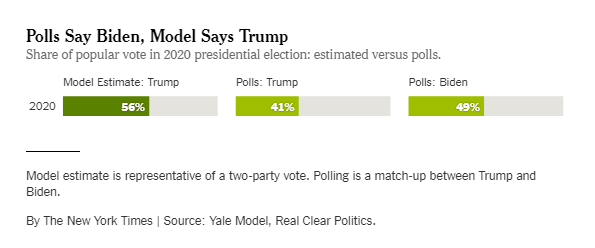Last week, Steven Rattner presented charts on MSNBC’s Morning Joe showing that if the 2020 election were held today, Donald Trump would have a huge tailwind because of incumbency and the recent strong performance of the economy.
The economy invariably ranks among the top issues on the minds of voters in presidential elections. At the moment, it appears to offer President Trump a meaningful tailwind.
But how big is that tailwind? Fortunately, economists have worked hard to develop models for predicting election outcomes, and according to one of the best of these, it should be quite large.
One of the first — and perhaps still the best — of these models was created by Ray Fair, a professor at Yale. He found that the growth rates of gross domestic product and inflation have been the two most important economic predictors — but he also found that incumbency was also an important determinant of presidential election outcomes.
How well has Professor Fair’s model worked?
In short, while not perfect, the Fair model has done remarkably well. In 2008, it predicted that Barack Obama would receive 53.1 percent of the popular vote; his share actually totaled 53.7 percent. In 2012, when Mr. Obama was running for re-election, its final estimate was a vote share of 51.8 percent, just two-tenths of one percent less than what the incumbent president received. (For Mr. Obama in 2012, the power of incumbency helped offset a still-recovering economy.)
When the 2016 election rolled round, a surprising result emerged. According to the model, Donald Trump should have received 54.1 percent of the vote; in actuality he received 48.8 percent. I’m quite confident that the gap was a function of the generally unfavorable rankings on Mr. Trump’s personal qualities. In other words, a more “normal” Republican would likely have won the popular vote by a substantial margin (instead of losing it by three million votes).
A good part of Mr. Trump’s edge in 2016 was the incumbency factor — after eight years of a Democratic president, voters would ordinarily have wanted a Republican. (Since 1952, only one man has become president following eight years of a president of the same party.) In 2020, incumbency will be a tailwind for Mr. Trump as the vast majority of presidents are chosen for a second term.
In its present state, the economy will also be helpful to the president. All told, Mr. Trump’s vote share would ordinarily be as high as 56.1 percent. But that’s before factoring in his personality. As recent polls show, if the election were today, he would lose to most of the Democratic hopefuls by a substantial margin; in the case of Joe Biden, by nearly eight percentage points.
It’s worth noting that the Fair model is hardly alone in its forecast. Mark Zandi, the chief economist at Moody’s Analytics, has looked at 12 models, and Mr. Trump wins in all of them. Donald Luskin of Trend Macrolytics has reached the same conclusion in his examination of the Electoral College.
So the question for 2020 may well be whether Mr. Trump can overcome the majority of voters’ poor perception of him and use a good economy and incumbency to win re-election.
Analysis and charts are also posted on The New York Times Opinion page.








